





Marty Ross is a garden journalist and gardener who lives in Kansas City, MO, and Virginia’s Tidewater region. She has a community garden plot and grows lettuce and herbs in pots on her front porch.
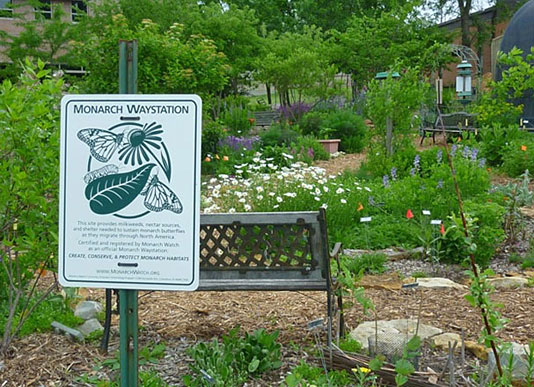
A certified monarch haven. Photo: Monarch Watch
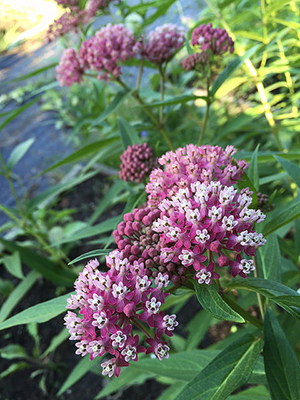
At Gardener's Supply, we are building a pollinator waystation on a swampy slope beside a parking lot. It's part of our Company Farm project, which encourages companies to create space for employees to grow food for the hungry — and pollinators. Shown here is the appropriately sited swamp milkweed (Asclepias incarnata).
MONARCH butterflies making their way back to North America from their winter habitat in Mexico follow a well-marked trail. These striking orange-and-black butterflies are looking for one thing: milkweed (asclepias). And when you plant milkweed in your garden, it's like rolling out a welcome mat for monarchs.
Spring is the beginning of the monarch's breeding season, and milkweed is crucial to survival of the species. Many flowers — especially native plants — are terrific sources of nectar for monarch butterflies, but milkweed leaves are the only food monarch caterpillars eat. Monarchs butterflies lay their eggs on milkweed plants so the tiny caterpillars will have access to food the moment they hatch.
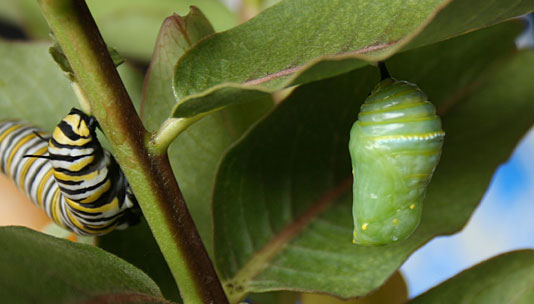
A monarch caterpillar, left, and a chrysalis. Photo: Suzanne DeJohn
Millions of acres of habitat for monarch butterflies and other important pollinators have been lost to development and agriculture in recent decades. Planting your own little milkweed preserve will help the monarchs and other pollinators. Katie-Lyn Bunney, coordinator for the Monarchs in the Classroom program at the University of Minnesota Monarch Lab, says, "We tell everybody that there are things they can do to help monarchs, and the first thing is to plant milkweed."
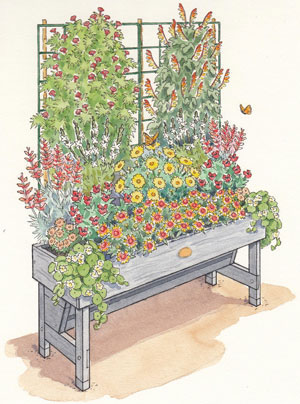
In just 5 square feet, you can attract dozens of pollinators. Get the plan for this garden, created for the Trough Vegtrug, which is 18"x40".
You don't have to have a big garden to make a difference. "You can create a monarch waystation in a flower pot," Bunney says.
Planting a monarch waystation is easy — even for schoolchildren, Bunney says. Milkweed seeds can be sown directly in the ground, but starting them indoors improves germination and lets you nurture the seedlings. According to the group Monarch Watch, plants grown until they are sturdy seedlings have a higher survival rate when planted out in the garden. Monarch Watch advocates for these butterflies in many ways, including a certification program for gardeners, schoolyards, community gardens and natural areas. More than 7,400 waystations have been certified, says director Chip Taylor, but more are needed. "We need the gardeners of America to step up to help save the monarchs," he says. To help make it easier, Monarch Watch designed a monarch waystation seed kit.
The most effective monarch waystations cover at least 100 square feet, but even small-scale plantings can help, Monarch Watch says. A waystation might be part of an herb garden, a dedicated raised bed or a section in a vegetable garden; it can be part of existing garden beds or along a property line. Choose a spot in sun: butterfly plants need at least six hours of sun a day. Almost any kind of soil is acceptable, but light, well-drained soil is best. A good butterfly garden also provides shelter from the wind: the sunny side of a solid fence, garage, or garden shed is a good place for a waystation. Dense plantings, with tall and short plants, help with the wind, too, and also give butterflies shelter from predators.
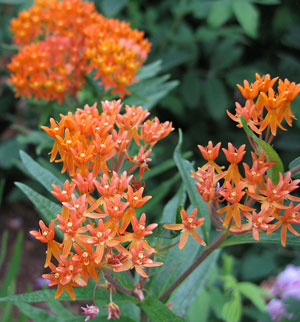
Butterfly milkweed (Asclepias tuberosa) has showy flowers.
Monarch waystation seed kits contain different milkweed species for different areas. East of the Rocky Mountains, Monarch Watch recommends common milkweed (Asclepias syriaca), swamp milkweed (A. incarnata, which tolerates moist sites) and butterfly milkweed (A. tuberosa). West of the Rockies, butterfly milkweed and swamp milkweed are still good choices, along with narrow-leaf milkweed (A. fascicularis) and showy milkweed (A. speciosa). By planting at least two milkweed species, as well as other nectar-rich plants, you'll attract monarchs and other pollinators throughout the breeding season. If you're not sure what type of milkweed is appropriate for your area, a checklist of species organized by states and regions — and a list of nurseries that carry plants — is available on Monarch Watch's Milkweed Market.
When the monarchs discover your waystation and stop for nectar, the females will lay their eggs on the milkweed plants. You'll have the pleasure of watching the gorgeous black, yellow and white caterpillars emerge and feed on the foliage. If your waystation is a success, the milkweed will start to look a little tattered as the caterpillars grow, but milkweed plants are tough perennials, and they'll recover.
After you create a monarch waystation, make it official. You can certify and register your waystation online (the fee is $16, which supports Monarch Watch programs), and purchase a Monarch Waystation sign. When they see the sign, the milkweed and the monarchs fluttering about, some of your neighbors might get the notion to do their bit for the butterflies, too.
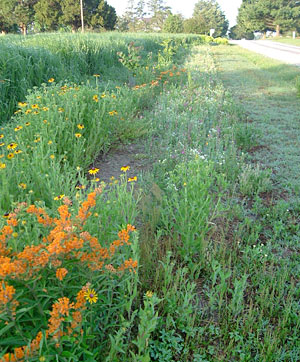
Photo: Marty Ross
Before we bought our property in Virginia, our 1-acre field was planted with soybeans. As a conservation effort, we transformed the land into an ever-changing haven for butterflies, bees, birds — and a few groundhogs.
We started in 2002 by planting seed for meadow plants, along with a "nurse crop" of oats. The quick-growing oats nurture the slower-growing perennials and help block weeds.
The first year the meadow was a sea of black-eyed Susans (rudbeckia). In time, the butterfly milkweed has become well-established. Today the meadow includes native warm-season grasses (Panicum virgatum is the dominant grass), rudbeckia, butterfly milkweed (Asclepias tuberosa) and some partridge pea. We have supplemented the original plantings with two more kinds of milkweed (A. syriaca and A. purpurascens). Goldenrod (solidago) has come in on its own, and we have added some, so there are at least two species of solidago, along with bee balm and asters.
The meadow also supports lots of wildlife, including rabbits, songbirds and groundhogs (not our favorite). Foxes are part of the community, too, making it difficult for the quail. Most of all, there are butterflies, especially when the milkweed starts blooming in early June.
Copyright © www.100flowers.win Botanic Garden All Rights Reserved